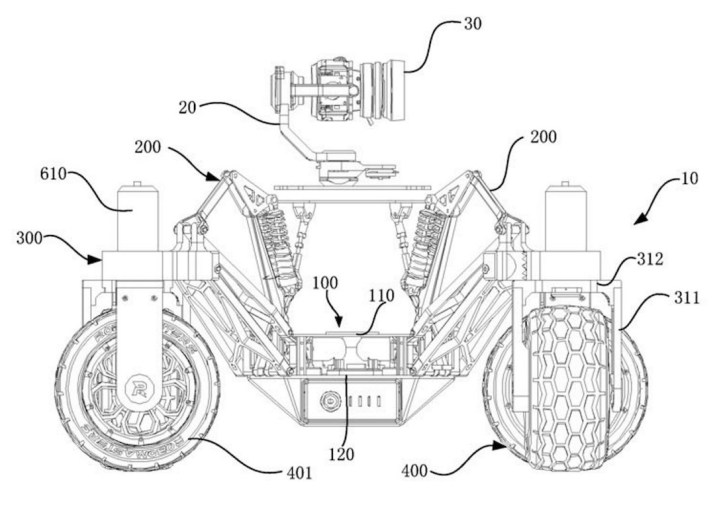
DJI is known for its popular drones — the Mavic 2 Pro and Zoom among them — but could the company be prepping the launch of a ground-based, camera-equipped remote-controlled rover in 2020?
A patent filed in China by the Shenzhen-based company suggests it may be considering such a device.
Spotted by DroneDJ, the patent describes a machine that is similar in some ways to the Freefly Tero, a small and zippy remote-controlled vehicle that lets filmmakers attach a camera for capturing low-level actions shots.
According to the very detailed diagram included in DJI’s filing, the battery-powered vehicle has four chunky wheels that can rotate 360 degrees for greater maneuvering capabilities, and a stabilizing system to ensure smooth footage as the machine rolls along a sidewalk or street, or even across more challenging terrain.
Looking closely at the image, we can see that the stablization system appears to use springs attached to a platform that supports the camera. Further stability is provided by the gimbal/camera setup that appears to feature one of DJI’s advanced Zenmuse cameras. This suggests the product would be aimed at more serious filmmakers rather than hobbyists looking for a fun toy to play about with.
Why a camera-equipped rover?
While a skilled drone operator will have the ability to capture low-level shots with a camera-equipped flying machine, a small rover would be easier to operate in interior situations, or in outdoor locations where space is tight. A machine like this would also be free of many of the strict regulations that govern the use of aerial drones, making it easier for users to fire it up without fear of getting into trouble with the authorities, though it should be noted that local rules for parks and other public areas may already restrict the use of ground-based remote-controlled vehicles.
As ever, we should remember that we’re looking at a patent here, so there’s a chance that the idea may stay on paper instead of becoming a real product that you can buy. DJI, however, is an ambitious company that’s constantly looking at new ways to broaden its business, and a product like this that draws on its existing knowledge of drones makes it feel like a real possibility.
We’ve reached out to DJI to ask how seriously it’s looking at such a product and will update this story when we hear back.
Editors' Recommendations
- DJI’s new Osmo Pocket 3 is an exciting upgrade
- The DJI Osmo Action 3 looks nothing like the Action 2
- DJI Mavic 3 roars to the scene with dual-cam Hasselblad camera
- DJI releases its Pocket 2 gimbal camera in a new color
- DJI Air 2S enters pro territory with its one-inch camera sensor and 5.4K video


